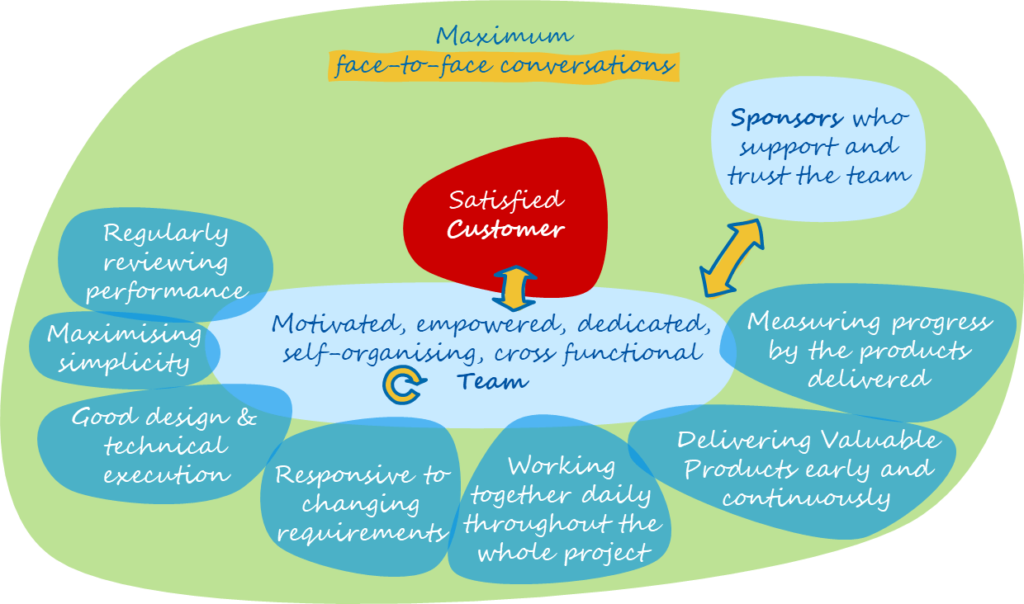What you need to know before making your innovation Agile
Agile Innovation fundamentally changed the way software companies create new products and it’s been creating a buzz in the food industry for a while now. But what is it exactly? Here’s what you need to understand before making your innovation Agile.
Agile in context
To fully understand Agile, you need to go back to the source. In February 2001, seventeen independent-minded software developers sat together in the Snowbird ski resort in Utah, USA to come up with ideas to improve the software development process. The main issue was that customer requirements were changing rapidly and traditional development methods were too slow to respond. By the end of their stay, they had written the Agile Manifesto. This is the source of Agile software development, the origin of everything Agile today.
Agile is not a tool, process or methodology
Search the Agile Manifesto as much as you want and you will not find a process, tool or method. It is a value statement and 12 principles that helped the software industry break away from heavily bureaucratic management systems that were stifling innovation and impairing new software delivery.
In fact, in the manifesto, they say that “we have come to value Individuals and interactions over processes and tools”.
You’ve probably heard about Scrums, Burndown Charts, Kanban and so on. It’s true that these are some of the methods used by Agile-oriented teams. However, these methods are typically presented as the things that make a process Agile. No, processes are Agile because teams and senior managers buy-in to the Agile manifesto and this changes the mindset of the organisation. The methods are enablers, chosen by the people doing the work because they help them behave in an Agile way.
Saying the methods make you Agile is like saying that having a stethoscope makes you a medical doctor.
Agile is firstly a shared mindset and underlying principles…
I won’t go into detail here (check out the link at the end for more information) but it’s worth quickly unpacking the Agile Manifesto and Principles. See boxes 1 & 2 and remember they were made specifically for software development.
Box 1 – The Agile Manifesto
We are uncovering better ways of developing software by doing it and helping others do it. Through this work we have come to value:
Individuals and interactions over processes and tools
Working software over comprehensive documentation
Customer collaboration over contract negotiation
Responding to change over following a plan
That is, while there is value in the items on the right, we value the items on the left more.
Box 2 – The 12 Principles of the Agile Manifesto
- Our highest priority is to satisfy the customer through early and continuous delivery of valuable software.
- Welcome changing requirements, even late in development. Agile processes harness change for the customer’s competitive advantage.
- Deliver working software frequently, from a couple of weeks to a couple of months, with a preference to the shorter timescale.
- Business people and developers must work together daily throughout the project.
- Build projects around motivated individuals. Give them the environment and support they need, and trust them to get the job done.
- The most efficient and effective method of conveying information to and within a development team is face-to-face conversation.
- Working software is the primary measure of progress.
- Agile processes promote sustainable development. The sponsors, developers, and users should be able to maintain a constant pace indefinitely.
- Continuous attention to technical excellence and good design enhances agility.
- Simplicity–the art of maximizing the amount of work not done–is essential.
- The best architectures, requirements, and designs emerge from self-organizing teams.
- At regular intervals, the team reflects on how to become more effective, then tunes and adjusts its behavior accordingly.
To implement Agile Innovation, you first need to understand the values and principles and figure out what they mean for your company. Then you look at methods, tools, techniques etc that will support the Agile behaviours you want to promote.
…so firstly, understand how Agile could look and feel in your company…
If I were to distil down the essence of the Agile manifesto, it would look something like this:
A motivated, empowered, dedicated, self-organising, cross functional Project Team works together daily throughout the whole project. They are totally focussed on satisfying the Customer, collaborating closely with them to deliver Valuable Products early and continuously. The delivery of Valuable Products to the Customer is the main measure of project progress.
The Team is responsive to changing Customer requirements while striving for maximum simplicity, good technical execution and design excellence. They regularly review their performance and adapt their behaviour accordingly.
The Team is supported by senior Sponsors who provide trust and create the right working environment. Communication between all parties is mainly through face-to-face conversation. This way and rhythm of working can be maintained indefinitely.






